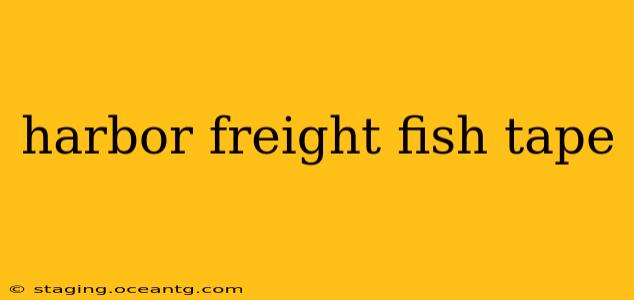Finding the right fish tape can be crucial for navigating tight spaces and completing electrical or plumbing projects efficiently. Harbor Freight, known for its affordable tools, offers a range of fish tapes, making it a popular choice for both DIY enthusiasts and professionals on a budget. This comprehensive guide will delve into the world of Harbor Freight fish tapes, exploring their features, uses, and how to choose the right one for your needs.
What is a Fish Tape and Why Would I Need One?
A fish tape is a flexible, long ribbon-like tool used to pull wires, cables, or pipes through conduits, walls, or other confined areas. Think of it as a slender, strong snake that guides your cables to their destination, saving you time and frustration. It's an essential tool for electricians, plumbers, and anyone tackling DIY projects involving running wires or pipes in hard-to-reach places. The flexibility and strength of the tape allow it to navigate bends and turns, making it far easier than trying to push or pull cables directly.
Harbor Freight Fish Tape Options: A Variety to Choose From
Harbor Freight offers several types of fish tapes, each catering to different needs and budgets. They range from basic, more affordable options to those with advanced features. Understanding the differences is key to selecting the right tool for your task. These often include:
- Standard Fish Tapes: These are usually made of steel and offer good flexibility and strength for general use. They're a cost-effective solution for occasional use or smaller projects.
- Heavy-Duty Fish Tapes: These tapes are designed for more demanding applications, often featuring thicker, more durable construction, and sometimes a reinforced tip for improved durability when navigating difficult spaces.
- Flexible Fish Tapes: Offering enhanced maneuverability, these tapes are ideal for navigating particularly tight bends and complex pathways.
While Harbor Freight doesn't always list specific materials on their website, looking at customer reviews can often provide insight into the durability and performance of each model.
How to Choose the Right Harbor Freight Fish Tape
Choosing the right fish tape depends on several factors:
- Length: Consider the distance you need to reach. Harbor Freight offers various lengths, from shorter tapes suitable for household projects to longer ones for more extensive work.
- Material: Steel is the most common material, but some tapes may use other metals or composite materials. Consider the required strength and flexibility.
- Tip: The tip of the tape plays a crucial role. Some tapes have a rounded tip for easier insertion, while others have a pointed or reinforced tip for navigating tighter spaces or potentially harsher environments.
- Budget: Harbor Freight's affordability is a major draw, but even within their range, prices vary. Determine your budget and choose a tape that meets your needs without breaking the bank.
What are the Limitations of Harbor Freight Fish Tapes?
While Harbor Freight fish tapes offer good value, it's important to be aware of potential limitations:
- Durability: While generally durable for their price point, they might not match the longevity of higher-end professional-grade tapes. They may need replacing sooner if used frequently for heavy-duty applications.
- Features: Compared to more expensive brands, they might lack advanced features such as built-in lights or specialized tips.
Are Harbor Freight Fish Tapes Worth It?
The value proposition of Harbor Freight fish tapes centers on their affordability. For occasional use, DIY projects, or those on a tight budget, they represent a cost-effective option. However, for professional contractors or those who need a very heavy-duty, long-lasting tool, investing in a higher-end product might be worthwhile in the long run. The balance between price and expected use will determine if a Harbor Freight fish tape is the right choice for you.
How do I Use a Harbor Freight Fish Tape Properly?
Using a fish tape properly is crucial for both its effectiveness and your safety. Consult your specific tape's instructions for detailed guidance, but general best practices include:
- Start Slowly and Carefully: Gently feed the tape into the conduit or opening, avoiding sudden jerks that could damage the tape or cause it to bind.
- Use Caution: Avoid over-forcing the tape, as this could lead to bending, breakage, or injury.
- Keep it Straight: Try to maintain a straight line as much as possible to prevent tangling.
- Appropriate Safety Gear: Always use appropriate safety gear, including eye protection and gloves.
Where can I find replacement parts for my Harbor Freight fish tape?
Harbor Freight offers a warranty on their tools, so checking their website or contacting their customer service will be the best way to determine how to get parts or repair your fish tape.
This guide provides a comprehensive overview of Harbor Freight fish tapes. Remember to carefully consider your needs and budget before making a purchase. By understanding the different types and limitations, you can choose the right tool for your project and enjoy the benefits of this essential piece of equipment.
